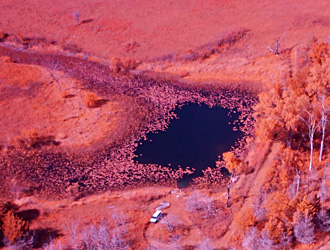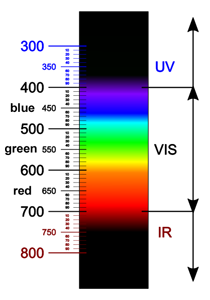
| Aerial Photography
J.S. and S.W. Aber |
| Introduction | Film CIR |
| Digital CIR | Comparison |
| References |

| Aerial Photography
J.S. and S.W. Aber |
| Introduction | Film CIR |
| Digital CIR | Comparison |
| References |

| Spectrum of ultraviolet (UV), visible (VIS), and near-infrared (IR) radiation. Primary visible colors are blue, green, and red. Wavelengths given in nanometers (nm). Image adapted from Wikimedia Commons. Note: this discussion deals only with near-infrared. Thermal (heat) infrared is much longer wavelengths and requires completely different imaging techniques. |
Traditional color-infrared (CIR) photography is based on green, red, and NIR layers in the film emusion, and blue/UV light is excluded by use of a yellow filter. As developed into a visible picture, green is shifted to blue, red becomes green, and NIR appears red. This shifting of spectral bands is known as false-color imagery.

| Analog (film) photographs of the Emporia State University campus, Kansas. Color-visible (A) and color-infrared (B) show dormitory buildings, parking lots, trees, and part of the football stadium. Active vegetation appears in pink, red, and maroon colors in the CIR image. Images acquired with a dual-camera rig. | 
|
Starting in 2008, we tested the Tetracam ADC at several sites in Kansas, Pennsylvania, and Massachusetts. Because of its relatively high cost we flew it only under ideal conditions, but the image quality was disappointing, so we quit using this camera the following year.
| Type of imagery | False color | Vegetation | Clear water | ||||
|---|---|---|---|---|---|---|---|
| G = blue | R = green NIR = red = maroon | = near black B = blue | G = green NIR = red = orange | = dark blue |
Color-infrared photos tend to enhance special lighting effects, for example sun glint and the hot spot. Sun glint is a mirror-like reflection from water bodies, metal and glass structures, etc. The hot spot is the position on the ground at the antisolar point in direct alignment with the camera and sun. It appears bright because of shadow hiding (Hapke et al. 1996).

| In oblique views looking toward the sun, bright pink-white streaks may appear in some images taken with the modified Sony camera. This is presumably due to internal lens reflections. |
![]()
![]() Return to KAP cameras or KAP home.
Return to KAP cameras or KAP home.
Last update: February 2019.